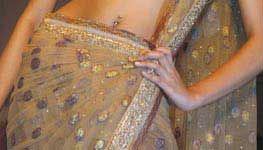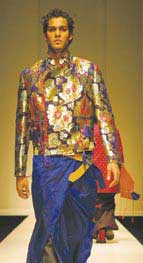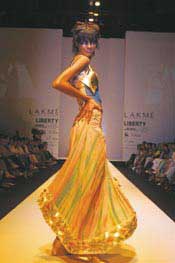Life
All These Trimmings

|
From kasida to dabka, lace and even buttons, style, this season, is about how you decorate your garment.
Shadow work mixed with buckles, buttons on sleeves, texturing, edging, appliqué with distressed edges, crystals on laser work, zardozi, gota, pin-tucks, pleats, smocking, layers. If there is a God of fashion, it is clearly in details this festive season and moreover intent on mix and match. Says Priya Awasty, the designer who is brought out her bridal prêt collection for fall-winter, “It is a trend internationally and now boundaries are blurred as far as regional and national looks go.” Traditionally Indian clothes have laid almost as much emphasis on the embellishment as they have on the cut and the fabric. Designer Ritu Kumar says the odhani is the biggest embellishment there is. She adds, “We had zardozi even 1000 years ago. Today embroidery has become a generic part of Indian couture. Using the metallic look with zari or hreflective surfaces for embellishment is India’s contribution to the world.”
According to her, crossovers of different embroidery, albeit governed by region-specific rules is not new to India. She cites Kutchi women using thread work with their mirrors as one example. She herself has used brocade edging together with zari borders on kurtas and lehangas, even as the other classicist Anuradha Vakil put Shabana Azmi in a silk kurta with paithani borders and kasida. Says Awasty, “Earlier one embellishment was enough. A woman in Bengal would painstakingly do kantha for a good 8-9 months on a saree before taking it out for an occasion. Today even that is mixed with abla, sequins and mirror work. It is evolution.” As Indian fashion moves from ethnic to aesthetic, designers are defining embroidery and using it as a signature. Whether it is Rajesh Pratap Singh’s shadow work polka dots mimicking appliqué, Rohit Bal’s use of tied saree tassels on men’s shirts or chikankari jaal recreated in gota with distress, Payal Jain’s rooster-patterned zari patches under the lapels of a kimono top, Krishna Mehta’s smocking that looked like tukda-bandhej or Aki Narula’s “sofa-inspired” cloth buttons placed in the centre of twisted fabric of skirts, each designer is finding a reinterpretation. Says designer Narendra Kumar Ahmed who has developed prints inspired by the art deco buildings of Marine Lines in Mumbai, “I wanted to have clothes hreflective of each area of the city. We have combined pitta metal thread work with prints, matted it with sequins and still ensured that it does not become too heavy for a sports jacket.”
Sense in their sensibilities is the sign of a maturing fashion industry, even as it decides the pedestal-worthiness of the designer. Says designer Ashish Soni, the minimalist designer who is bringing out the seams of his men’s jackets, tearing up edges of appliqué flowers before putting them on skirts and with it still managing understatement, “Ten years ago perhaps I would not have been done all this. With the designer, the market has evolved and so has the customer.” So the more embroidery there is, the more expensive the garment, is clearly not the benchmark. Sabyasachi Mukherjee, who calls a patchwork of fabrics, trends or silhouettes, his signature says, “There has to be logic and balance in use of ornamentation. You don’t do embroidery because labour in India is cheap or you have the means or access to a type of work. You do it because it goes with the story that your garment is telling.”
Everything may not be in its place but clutter isn’t necessarily the alternative. Ritu Kumar comments, “Embroidery should add something to the garment not take away from it and draw attention to itself.” |





You must be logged in to post a comment Login